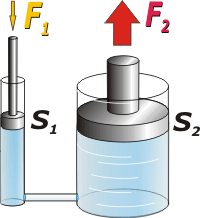 |
NO ME SALEN
(THEORETICAL NOTES OF BIOPHYSICS)
FLUIDS
PASCAL'S LAW - HYDRAULIC PRESS |
|
|

|
| |
Pascal’s Law
Blaise Pascal (1623-1662) stablished – and both gases and liquids have been obeying since then – that every pressure applied on a fluid confined in a container is transmitted equally to each and every point of that fluid and wall of the container.
Let’s take a look at the following tube: it has a given fluid inside and a bunch of holes closed with wine bottle caps.
|
 |
|
|
If we applied a strong and fast pressure on the left bottle cap, it’d be logic to think that the one on the right, and only that one, would be blown out. Yet, all six bottle caps are blown out the same. The pressure difference was transmitted to every point and in every direction equally.
Fluids logic is a bit different than solids. In order to describe a solid, the first thing we talk about is its mass; when it’s a fluid, its density. When referring to solids, we speak of force; in fluids, pressure. |
|
|
Hydraulic Press
Pascal’s Law has a more than practic use: hidraulyc press. It consist in a closed recipient with two pistons. One (1) of a bigger cross-sectional area than the other (2). |
|
|
Applying a force, F1, on the small piston, you get a bigger force, F2, on the largest piston. So, the hydraulic press is a force amplifier. It’s amazingly simple.
Let’s put both pistons at the same height. There, by the general law of hydrostatics, we guarantee that there will be no pressure difference between the both. If we then apply a force F1 on the small one, it will be distributed all across its area, S1. We can therefore define a pressure, P1.
|
 |
|
|
|
Thanks to Pascal, we can also guarantee that the pressure on the other piston will be the same. So:
P1 = P2
F1 / S1 = F2 / S2
What we care about here:
F2 = F1 . ( S2 / S1)
So F2 force will be ( S2 / S1) times bigger than F1. The biggest the area on the big piston compared to the area on the small one, the biggest the factor by which we have to multiply F1. For example, if section two is a hundred times bigger than section one, the resulting force in 2 will be a hundred times bigger than F1. |
|
|
Important Gossip: |
 |
- Hydraulic press is not the only forces amplifier, yet is the one chosen by industries and mechanics in general. Hydraulic jacks, mechanic arms, lifters, most robots…anything you can think of within industries is moved through forces derived from hydraulic presses.
|
|
|
|
| Tricky Questions: |
|
 |
- Why is it that Pascal’s Law does not seem to be affected by hydrostatics general law? Shouldn’t there be a pressure difference due to the different height between the bottle caps or the pistons?
- If the narrow piston, because of force F1, is moved by a liquid of a volume V, what volume of liquid will be moved on the big piston because of F2? Which of both pistons has to move longer? How much longer?
|
|
| |
|
| Translated by Matías Varela. Some rights reserved.
Be copied by quoting the source. Last updated
sep-07. Buenos Aires, Argentina. |
|
|
| | |
|
|
